| PROTO-POLYNESIAN ETYMOLOGIES |
| *Pau [Proto Polynesian] |
(A hardwood tree, possibly a species of Planchonella (Pouteria), Sapotaceae). |
|
| From
PROTO OCEANIC *bau, a general name for hardwood trees in the family Sapotaceae. |
Proto Polynesian: *Pau
REFLEXES IN SOME POLYNESIAN LANGUAGES:
Samoan: Pau (Manilkara samoensis, Sapotaceae)
Rennellese: Pau (Plancholella sp., Sapotaceae)
Maori: Pau (Nestegis cunninghamii, "Black Maire", Oleaceae)
|
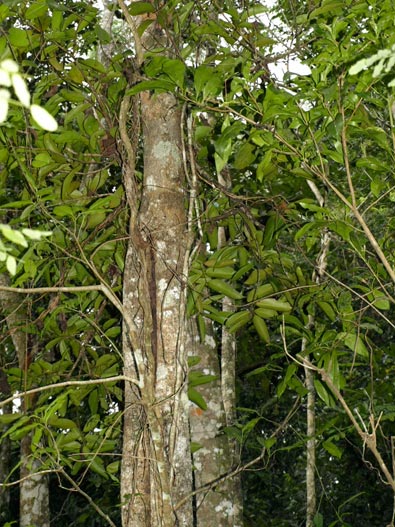
Trunk of Manilkara samoensis, Pau
(Falealupo Forest Reserve, Savai'i, Samoa) |
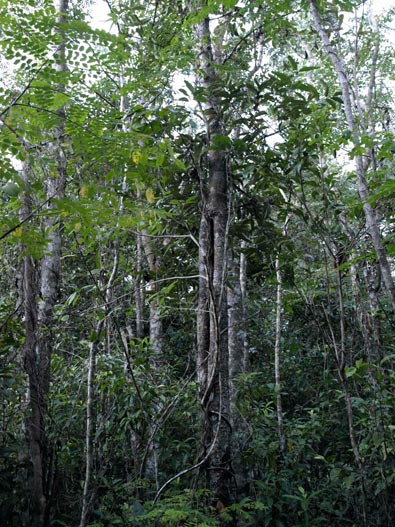
Natural habitat of Manilkara samoensis, Pau
(Falealupo Forest Reserve, Savai'i - the darker leaves are those of the Pau!) |
|
|
COGNATE REFLEXES IN SOME OTHER AUSTRONESIAN LANGUAGES
Teop (Bougainville): Bau (Leea tetramera, Vitaceae)
Bauan (Fiji): Bau (Palaquium sp., Sapotaceae)
Wayan (Fiji): Bau (A general name for a group of hardwood trees including Burckella richii, Manilkara vitiensis, Palaquium fijiense,and Planchonella species, all members of the Sapotaceae) |
|
RELATED WORDS
Samoan: Manapau (Mammea glauca, Clusiaceae).
|
At the end of the entry for Planchonella garberi (Sapotaceae) in his book Flowering Plants of Samoa (p.171), Erling Christophersen notes:
On the Falealupo peninsula of Savaii a sapotaceous tree is found, the
native name of which is pau. The reddish wood of this species is the favorite
material for war clubs and spears and is as such known all over Samoa,
though the tree is said to grow nowhere else but on this peninsula.
This tree is the Pau, Manilkara samoaensis (in some works referred to as M. hoshinoi), renowned for its very hard and durable wood. That quality is also reflected in its New Zealand namesake, the black maire, Nestegis cunninghamii. Although in Aotearoa was given to a tree from the olive family, rather than one of the Sapotaceae, the quality of the timber and general appearance of the tree and its fruit are reminiscent of its Samoan counterpart.
Changes in land use and excessive logging have endangered native forest ecosystems throughout the Pacific, and the pau is one of many species at risk of extinction as a result. Efforts are now being made to propagate this valuable tree and cultivate it outside its very restricted natural range. Some researchers think that managed native forests along with conservation areas are vital to assure the survival of the majority of native species in the Pacific Islands. (See T. Pouli et al., "Conserving the Pacific Islands' Unique Trees: Terminalia richii and Manilkara samoensis in Samoa, in the International Forestry Review, Vol 4 No 4, December 2002, pp. 286-291.)
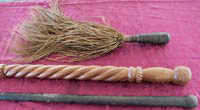 I was able to take the photographs on this page on a visit to Samoa in July 2015, in the Botanical Gardens in Tiapapata, Upolu, and also in the tree's natural habitat, the forest in the Falealupo district at the westerm tip of the island of Savai'i. The label for the specimen in the Botanical Garden notes that it is "Best wood for making axe handles and staffs". The inset shows a ceremonial fly whisk and orator's ceremonial and walking staffs made from pau wood, which I was able to photograph in the village of Neiafu, Savai'i, thanks to the kindness of our host. I was able to take the photographs on this page on a visit to Samoa in July 2015, in the Botanical Gardens in Tiapapata, Upolu, and also in the tree's natural habitat, the forest in the Falealupo district at the westerm tip of the island of Savai'i. The label for the specimen in the Botanical Garden notes that it is "Best wood for making axe handles and staffs". The inset shows a ceremonial fly whisk and orator's ceremonial and walking staffs made from pau wood, which I was able to photograph in the village of Neiafu, Savai'i, thanks to the kindness of our host.
|
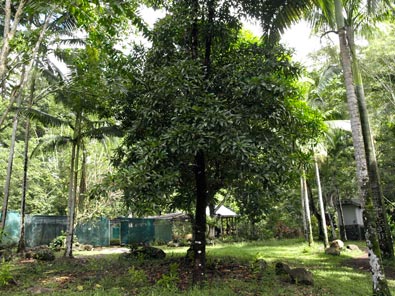
Manilkara samoensis, Pau
(Botanical Gardens of Samoa, Tiapapata) |
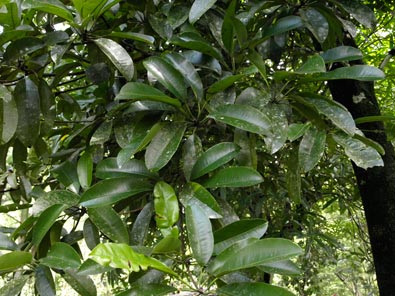
Leaves of Manilkara samoensis, Pau
(Botanical Gardens of Samoa, Tiapapata) |
|
| Further information : (See the books by Art Whistler on Samoan Rainforest Trees and Plants in Samoan Culture, publication details in the Bibliography). |
| Photographs: (R.B., Te Māra Reo) |
|
|

